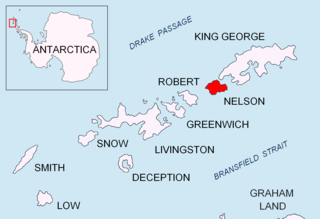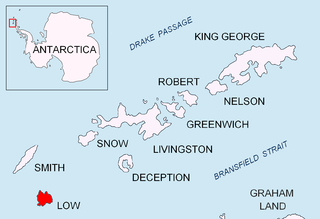
Mount Kliment Ohridski is the highest ridge (1422m) in the Sofia University Mountains on Alexander Island, Antarctica. The feature extends 7 km in the northwest–southeast direction with partly ice-free southern slopes. Shaw Nunatak is located in Nichols Snowfield 4 km off the southeast extremity of Mount Kliment Ohridski.

Kuzman Knoll is a solitary ice-covered knoll rising to 620 m in eastern Livingston Island in the South Shetland Islands, Antarctica. The knoll forms a conspicuous landmark in Wörner Gap area, overlooking Huron Glacier and upper Perunika Glacier. It was named after Kuzman Tuhchiev, participant in the 1993/94 Bulgarian Antarctic campaign and base commander at St. Kliment Ohridski during the 1994-96 seasons.

Rezovski Creek is a meltwater stream located on Livingston Island, Antarctica.

St. Kliment Ohridski Base is a Bulgarian Antarctic base on Livingston Island in the South Shetland Islands.

Vergilov Rocks are a group of rocks off Bulgarian Beach on Hurd Peninsula in eastern Livingston Island in the South Shetland Islands, Antarctica, consisting of one main rock and two adjacent smaller ones submerging at high water.

Camp Academia is a geographical locality in eastern Livingston Island, South Shetland Islands, Antarctica, named for the Bulgarian Academy of Sciences in appreciation of the Academy’s contribution to Antarctic exploration. The site was first occupied in the 2004/05 austral summer, and has been designated since 2004 as the summer post office Tangra 1091, the southernmost branch of the Bulgarian Posts Plc.

The Antarctic Place-names Commission was established by the Bulgarian Antarctic Institute in 1994, and since 2001 has been a body affiliated with the Ministry of Foreign Affairs of Bulgaria.

The Tangra 2004/05 Expedition was commissioned by the Antarctic Place-names Commission at the Ministry of Foreign Affairs of Bulgaria, managed by the Manfred Wörner Foundation, and supported by the Bulgarian Antarctic Institute, the Institute of Mathematics and Informatics at the Bulgarian Academy of Sciences, Bulgarian Posts, Uruguayan Antarctic Institute, Peregrine Shipping (Australia), and Petrol Ltd, TNT, Mtel, Bulstrad, Polytours, B. Bekyarov and B. Chernev (Bulgaria).

Lyubomir Ivanov is a Bulgarian scientist, non-governmental activist, and Antarctic explorer. He is a graduate of the St. Kliment Ohridski University of Sofia with M.S. degree in mathematics in 1977. He earned his PhD from Sofia University in 1980, under the direction of Dimiter Skordev with a dissertation titled Iterative Operative Spaces, and was the 1987 winner of Acad. Nikola Obreshkov Prize, the highest Bulgarian award in mathematics.

Christo Pimpirev is a Bulgarian scientist (geologist) and polar explorer.

Hurd Peninsula lies between South Bay and False Bay on the south coast of Livingston Island in the South Shetland Islands, Antarctica. The Spanish Juan Carlos I Antarctic Base and the Bulgarian St. Kliment Ohridski Base are situated on its west coast.

Juan Carlos I Antarctic Base, named after the former king of Spain, Juan Carlos I, is a seasonal scientific station operated by Spain, opened in January 1988. Situated on Hurd Peninsula, Livingston Island in the South Shetland Islands, Antarctica.

Camp Byers is a Spanish seasonal base camp on Byers Peninsula, Livingston Island in the South Shetland Islands, Antarctica. The locality is also designated for use as an International Field Camp. When necessary for scientific research purposes, temporary camping is allowed elsewhere on the protected peninsula under certain conditions.

The St. Ivan Rilski Chapel at the Bulgarian base St. Kliment Ohridski on Livingston Island in the South Shetland Islands is the first Eastern Orthodox edifice in Antarctica, the southernmost Eastern Orthodox building of worship in the world, and one of eight churches on Antarctica.

The Lame Dog Hut is a building in St. Kliment Ohridski Base on Livingston Island in the South Shetland Islands, Antarctica. Presently the oldest preserved building on the island, since October 2012 the hut has been hosting the Livingston Island Museum, a branch of the National Museum of History in Sofia. It was the first permanent building established by Bulgaria in Antarctica, which laid the foundations for Bulgaria's systematic scientific research in the Livingston Island area under the Antarctic Treaty System. The building is a designated Historic Site or Monument of Antarctica.

Cacho Island is the conspicuous 250 m long in east–west direction and 100 m wide rocky island separated by a 160 m wide passage from Aktinia Beach on the southwest coast of Snow Island in the South Shetland Islands. Surface area 1.63 ha. The area was visited by early 19th century sealers.

Quesada Cove is the 2.5 km wide cove indenting for 1 km the north coast of Nelson Island in the South Shetland Islands, Antarctica west of Cariz Point and east of Meana Point. It is formed as a result of the retreat of Nelson Island's ice cap in the last decade of 20th century. The area was visited by early 19th century sealers.

Mateev Point is the conspicuous 43 m high rocky point projecting 490 m north-northwestwards into Berraz Bay on the north coast of Low Island in the South Shetland Islands, Antarctica. The area was visited by early 19th century sealers.

Belev Nunatak is the hill rising to 58 m on the small peninsula ending in Avitohol Point on the north coast of Livingston Island in the South Shetland Islands, Antarctica. It has a partly ice-free area of 0.25 ha extending 80 m in west–east direction and 60 m in south–north direction. The nunatak surmounts Hero Bay on the northeast, and is part of the glacial divide between Tundzha Glacier on the southeast and Berkovitsa Glacier on the west. The area was visited by early 19th century sealers.

Aleksandrov Ridge is the rocky, partly ice-covered ridge extending 4.7 km in north-northeast to south-southwest direction and 1.7 km wide, rising to 768 m on the west side of Lassus Mountains, northern Alexander Island in Antarctica. It surmounts Narechen Glacier to the south-southeast and Lazarev Bay to the west. The feature is named after the Bulgarian geodesist Borislav Aleksandrov, surveyor at St. Kliment Ohridski base during the 1998/99 and subsequent seasons.















